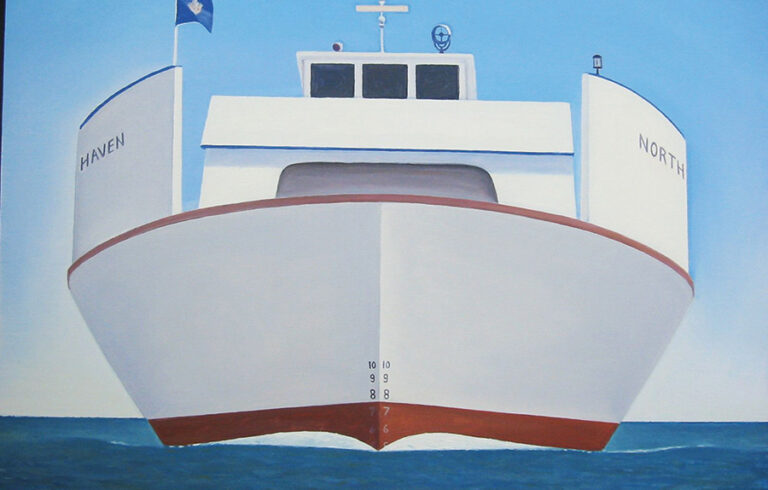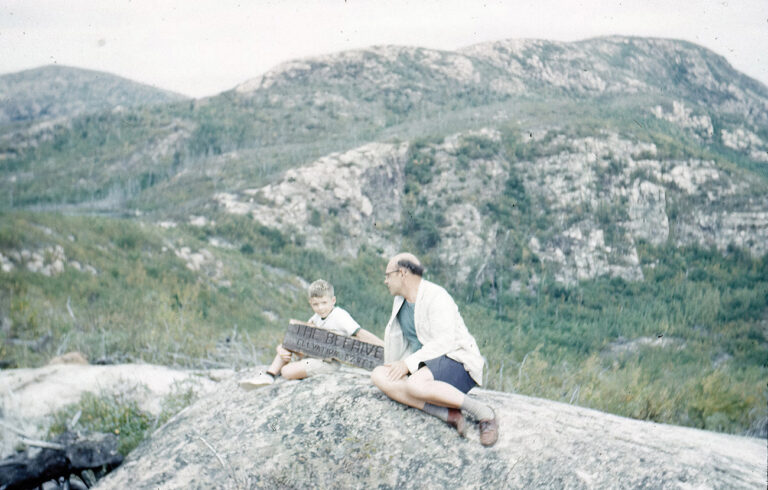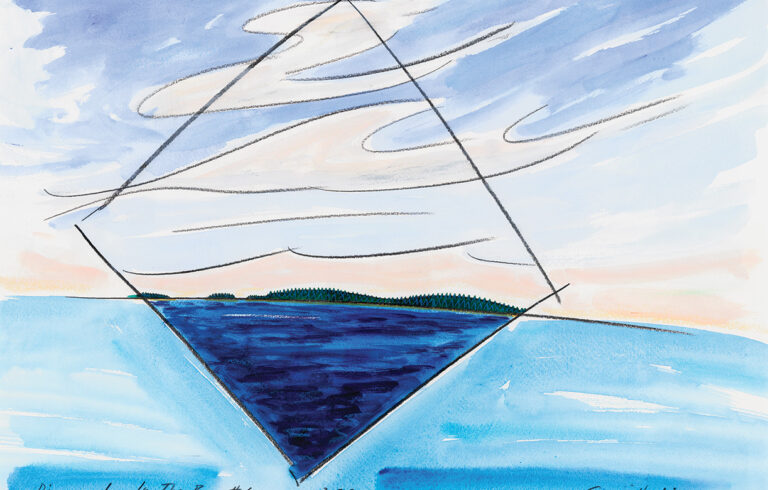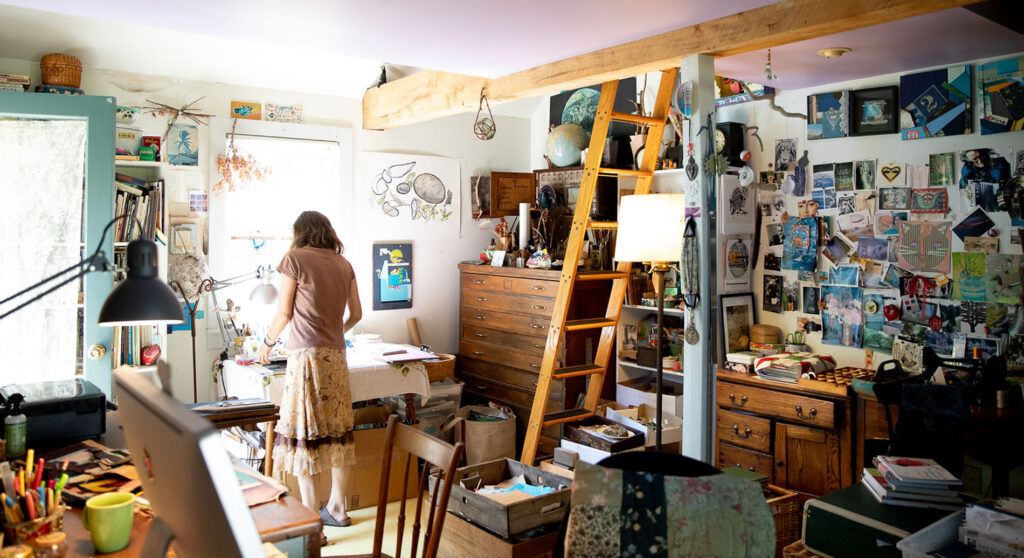
Photos by Claire Dibble
Brigadoon. Twice during conversation on a February morning, illustrator Scott Nash compared the residency program he and his wife, artist Nancy Gibson-Nash, set up on Peaks Island to that mythical Scottish village. True, the five or so-minute drive from the ferry terminal to the north end of the island—we took the scenic route—gives you a sense you are slipping the chains of civilization.
Yet arriving at Tolman Heights and entering the spacious new art studio there, you realize the place is very real and very welcoming.
This summer marks six years since Nash stood before the island’s Trefethen-Evergreen Improvement Association to share some ideas he had about illustration. Reticent to blow his own horn—his illustrating bona fides are well-known—he decided to try out a few pie-in-the-sky projects. In retrospect Nash chuckles at some of his schemes, including a line of artisan word-based rugs. When he began describing a school for illustrators on Peaks, ears perked up.
Referencing Monhegan’s famous summer art colony and such programs as the renowned Black Mountain College in North Carolina, Nash talked about bringing illustrators, narrative artists, and writers to the island, with complementary exhibitions and workshops offered to the community, which would include Portland.
His and Nancy’s vision of a school without buildings shifted when Peaks Island resident John Faison approached them with the offer of a site to start a residency program. Faison had been looking for a way to honor his late wife Marilyn and suggested his Tolman Heights property might serve as a haven for illustrators.
Around a century earlier the place had been a bohemian enclave, so the vibe seemed right. The original development, owned by Frederick T. Whitney, a wealthy Bostonian, featured a variety of structures, including a house built from New Hampshire stones and a 75-foot-tall observation tower erected, it is said, so the owner could see Mount Washington on a clear day (remnants of the latter remain).
Nash and Gibson-Nash mulled over the offer and came up with a vision of a sanctuary where artists working in illustration, animation, cartooning, graphic novels, and other narrative arts could work, recreate—do whatever they wanted to do.
Faison offered the original stone cottage and a four-bedroom guest house to serve as lodging. The couple launched the nonprofit Illustration Institute in 2016 with “Picture This…,” an exhibition of 17 contemporary illustrators at the Portland Public Library. The residency began the following summer.
Nancy remembers one of the first responses to their invitation to come to the island: “Hell, yeah!” Since then, around 80 artists have made their temporary homes on Peaks; there would have been more but for COVID (the 2020 season was cancelled). Participants are allowed to bring a spouse or a friend, their children, and even their pets, which has added to the community feel of the residency. The one- and two-week residencies run from May to September.
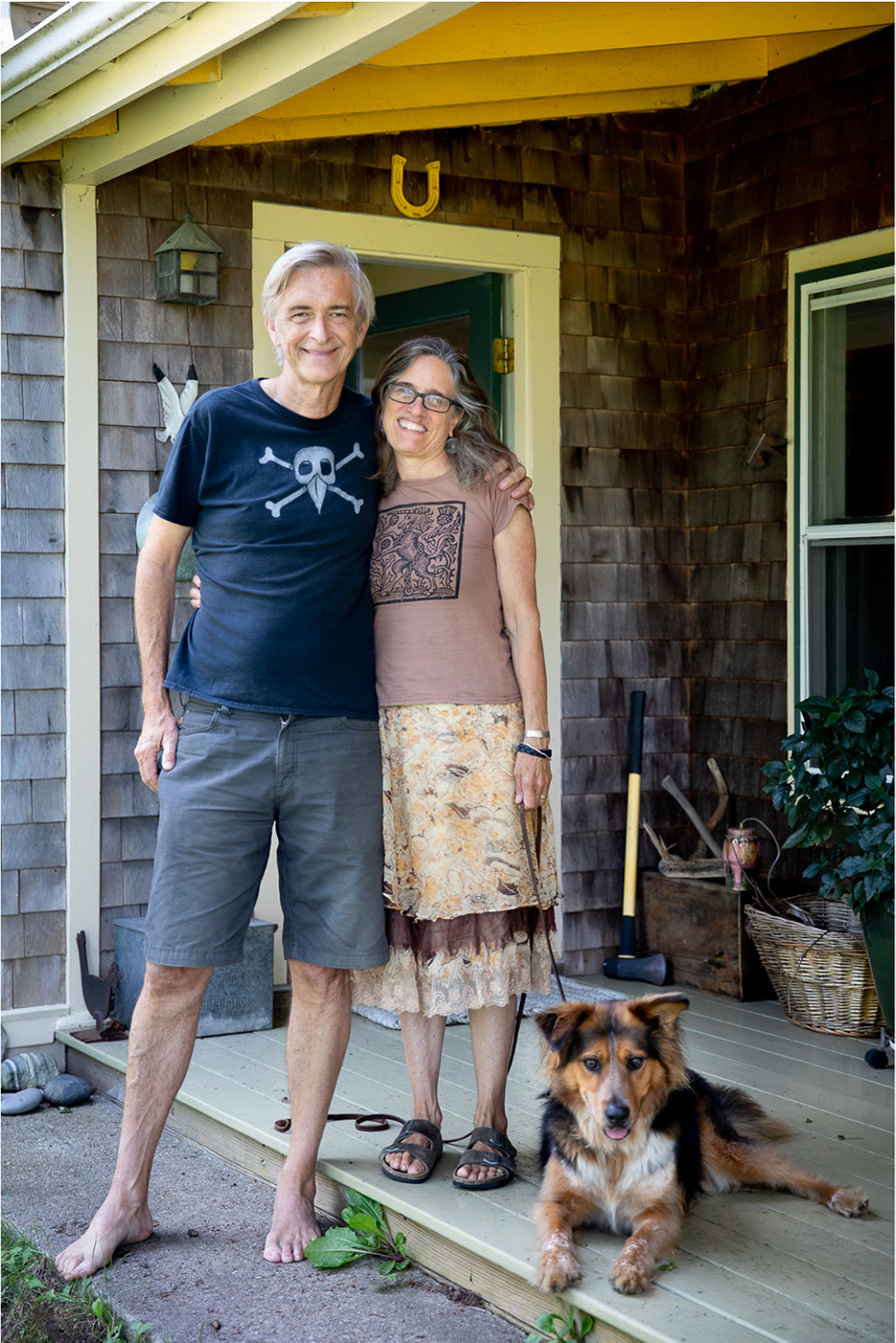
Scott Nash and Nancy Gibson-Nash, founders of the Illustration Institute.
From the start the program has been invitation-only. Nash and Gibson-Nash work closely with the Illustration Institute’s advisors, many of them esteemed illustrators, who make recommendations, as do resident artists. Once the list is finalized, they put out a general inquiry to the chosen artists.
Nash, who has been an educator for most of his professional life—he started the illustration department at the Maine College of Art and Design—is astonished by the generosity. “To have somebody like Emily Flake come here and give a three-hour workshop-talk on creating a single-panel cartoon is astonishing to me.” After that session, one of his former students said that it was one of the best experiences he had ever had, including his time at MECAD. “My nose got out of joint for a moment and then I realized, how brilliant is that,” Nash recalls.
The artists also have given back through the work they have created while on the island. Writer and editor Martha White worked on the book On Democracy, a collection of her grandfather E. B. White’s essays that was published in 2019. Children’s book illustrator Lizzy Rockwell came up with the idea for How Do You Feel?, a picture book that introduces youngsters to a range of emotions, and made a set of sketches during her residency in 2018. After her publisher gave her the green light, she returned to Peaks in 2021 to work on the final book. She is now sharing it in schools across the country.
Nash and Gibson-Nash take pride in the Institute’s role as incubator. “A thing that didn’t exist is now out in the world,” says Nancy.
A number of residents have returned to Peaks, as island-struck as their hosts. Nash mentions the renowned Argentinian cartoonist Ricardo Liniers Siri, who goes by Liniers, who first came in 2018 and returned to vacation on Peaks in 2021. New Yorker cartoonist Flake has been back a couple of times.
“They’re starting to talk about this being a place that is friendly to artists, that this is the place to be,” Scott says. What is more, says Nancy, “The idea of being at a residency on the coast of Maine is irresistible to artists all over the world.”
Nash and Gibson-Nash came to Maine in 2001, in essence to reconnect with their creative selves. Scott had a highly successful graphic design firm in the Boston area that had grown to three divisions with 80 employees, plus a spin-off, Big Blue Dot, where he developed designs for kids, a passion of his.
“You start building a company and then you realize as an artist that you’re doing more managing than creating,” he says.
The couple had friends in Portland and on visits they looked around at houses. One day, Nancy’s friend Marianne Lloyd, who had worked at Big Blue Dot, took her on a bike ride around Peaks Island. Halfway around she was wondering to herself, “What is this place?” She and Scott had grown up on Cape Cod and missed being near the water.
“I came home and told Scott, ‘We need to move to an island,’” a proposal he greeted with some reluctance. “If we’re going to move to a new place, I want to be in Portland,” he said, but his spouse “cast a spell” on him and when he recovered, they were at a closing on a Peaks Island home. “Honestly, Nancy was right,” Scott says: “I’ve never felt more connected to the community, the community here and in Portland.”
Part of the attraction of Peaks and Portland was the creative community they represented and how welcoming everyone was. And then there was the amazing line-up of illustrators on the island, among them, Doug Smith, Cynthia Jabar, Jamie Hogan, Marty Braun, Kevin Hawkes, and the late Tim Nihoff, all acclaimed for their children’s books and other narrative art.
“It certainly made me feel like I was at home,” says Scott, and he and Nancy soon got to thinking, “Well, this is an illustrator’s island.”
And it’s an illustrator’s state: The Institute has welcomed a host of well-known Maine-based picture book artists to the island, including Chris Van Dusen, Ashley Bryan, Kevin Hawkes, and Melissa Sweet. Crime novelist Brenda Buchanan and playwright Elizabeth Peavey have also found a writing refuge on Peaks.
And what of their own creative endeavors? With two assistants and an engaged board, the couple have been responsible for the program from the start. Somehow, they have managed to maintain their personal artist practices while managing the institute.
“To be honest,” says Nancy, “while the nonprofit is a full-time labor of love, it also constantly ‘fills the well’ for me personally.” To have the chance to be exposed to artists they admire and learn about their artistic process “has been nothing short of amazing and spurs the imagination in profound ways.”
The Institute’s exhibitions have also proved inspiring. She has had work in several of them, including a devilish-looking typewriter in “Illustrated Monsters by Monster Illustrators” and a “crazy couch” in “The Art of Mending.” The latter, a collaboration with illustrator Kate Gardiner, took her passion for found objects to a larger scale “and practical purpose”: The couch now resides in the library at Mechanics Hall in Portland.
Scott, too, draws on the energy of the resident artists. One of the side benefits of interacting with them is “gaining their insights and learning that many of us lead crazy, multi-gigged lives.”
He is currently writing two illustrated novels for kids and illustrating another, Bunny and Clyde, written by Megan McDonald. He continues to do graphic design through the NASHBOX studio in Portland and has returned to directing video production and animation through the Institute’s Drawing Is Thinking and Art & Story series.
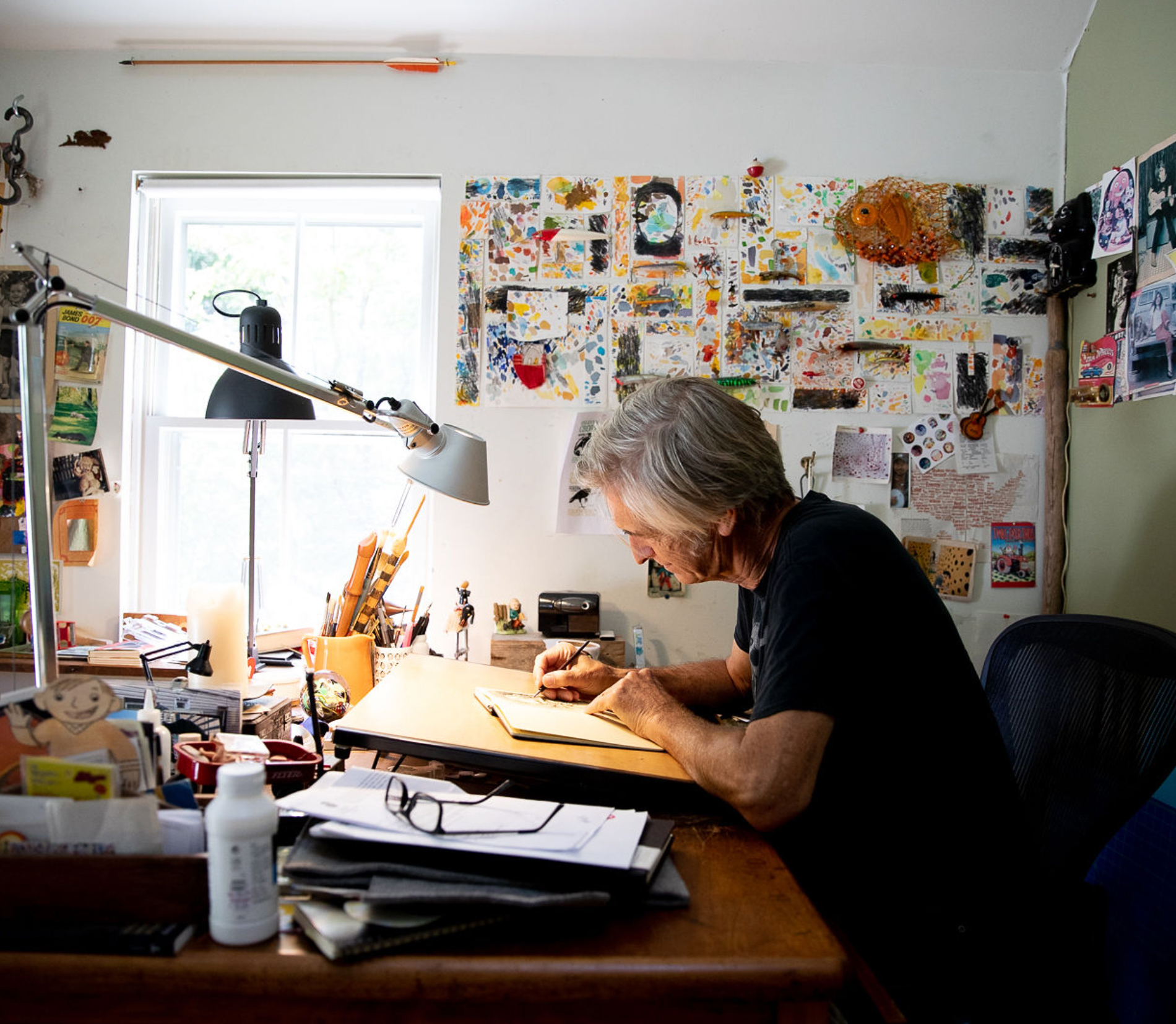
Scott Nash at the drawing board
The work of the Institute helps address a “trope” that has driven Scott nuts his entire professional career: that illustration is not art. He points to one of Garth Williams’s drawings for George Selden’s classic The Cricket in Times Square as an example of the genius they hope to convey about the art of illustrating, how in tune it is with the narrative and makes it whole. The Institute organized an exhibition of Williams’s illustrations at the Portland Public Library in 2019. Says Scott, “We want these artists to be recognized.”
Their next show is “The Great State of Illustration in Maine” at the Brick Store Museum in Kennebunk in the fall, which will feature such celebrated illustrators as Ashley Bryan, Daniel Minter, and Dahlov Ipcar.
Looking forward, Nash and Gibson-Nash want to deepen the Institute’s connection to the greater Peaks Island community. Maybe it’s more programs in the off season; maybe it’s additional residencies.
The Illustration Institute is evolving, says Scott, and he and his wife have been letting things happen more or less organically. “We didn’t have a grand mission statement,” he says, “but we are responding to how the artists and the community connect to what we’re doing.” He and Nancy find that arrangement “absolutely liberating and fascinating.”
For more on the Illustration Institute, visit www.illustrationinstitute.org.
Carl Little is the author of many art books, including The Art of Monhegan Island and monographs on Dahlov Ipcar, Mary Alice Treworgy, Eric Hopkins, William Irvine, Joel Babb, and Irene Olivieri. In 2021 the Dorothea and Leo Rabkin Foundation honored him with a Lifetime Achievement Award for his art writing. Little’s essay “Memorable Meals or How My Mother’s Manicotti Saved the Day” appears in Breaking Bread: Essays from New England on Food, Hunger, and Family. He and his brother David are working on their fourth collaboration, Paintings of Penobscot Bay (Islandport Press).

